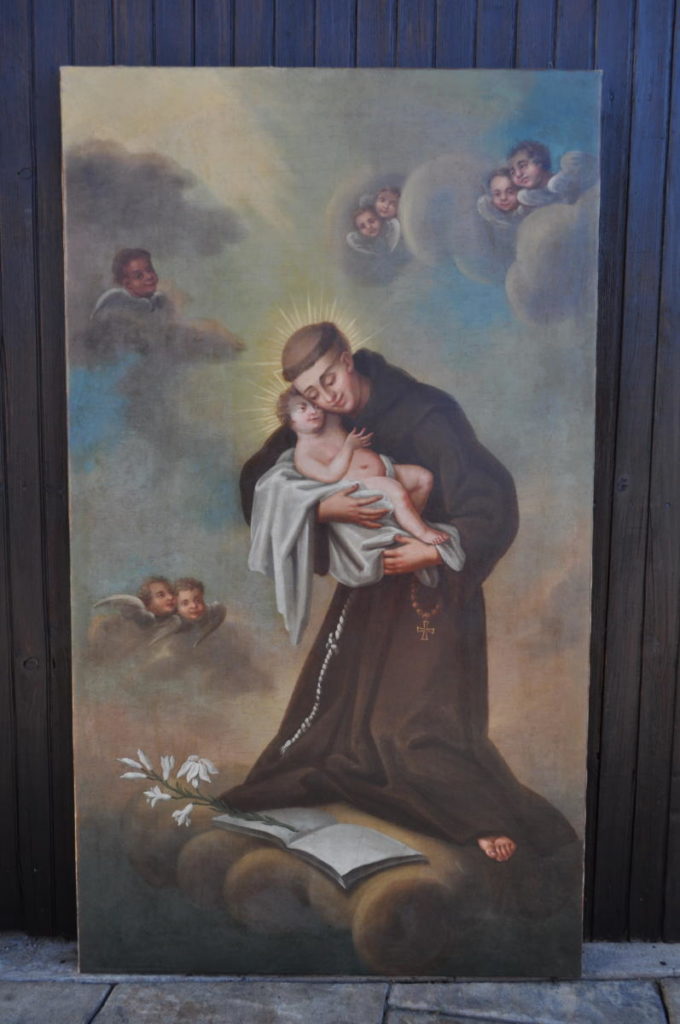
Church of st. John the Baptist in Zduny
RENOVATION OF THE PAINTINGS FROM THE SIDE ALTAR DEDICATED TO ST. JOSEPH FROM THE CHURCH OF ST. JOHN THE BAPTIST IN ZDUNY
Paintings of St. Joseph with Child and St. Anthony of Padua with Child from the side altar of the church of St. John the Baptist in Zduny were painted in the second half of the 18th century. They were restored in the last quarter of the 19th century and in 1981. Abrasions of the canvas and general disfigurement of the paintings’ face due to loosening of canvas tension were noticed. Earlier painting of St. Joseph had been cut out of the stretcher, glued and attached to an unoriginal carrier. The painting was encircled with black fastening tape, additionally reinforced with drawing pins. In the top right corner one could notice loosening of the canvas from the carrier as well as a hanging fragment of the painting. Lack of mobile stretcher and a proper tension of canvas caused numerous deformations in the shape of ripples and buckles.


The painting of St. Anthony of Padua had been attached to a sliding construction because fragments of nails which had attached the painting to the construction could be seen at the top edge. Lack of mobile stretcher and a proper tension on the canvas caused many deformations of the painting. Both paintings had been guarded on linen canvas and stretched to new chamfered stretchers with gores, but the procedure of straightening of the support had been omitted. Chalk-adhesive mortar was also in a very bed condition, deformations overlapped the losses and canvas deformations. Damages were caused by a high degree of dampness and work of canvas with improper tension. Paintings were covered with thick layers of darkened varnish distributed unevenly of the faces.
The aim of renovation was to restore the paintings to the best possible state by preventing destruction processes and eradicating exhibition (aesthetic) values. It was planned to restore original colours and recreation of blurred elements of composition.
Photographic documentation was made before the works. It was decided to re-guard the canvases. Edge acrylic putties which filled selvedges and partly covered the original layer of paint were removed from the face of the paintings. Putties were removed mechanically after the ablation of the retouch with solvent pastes and softening with distilled water. Then canvases were separated, the backs covered in the rest of guarding glue were preliminarily cleaned mechanically with a scalpel and hard brush. Secondly, the original layer of wax and resin guarding paste was extracted with white sprit and the guarding layers were removed with a scalpel again. The procedures were repeated three times. The stage of cleaning was finished with repeatable washing of the back with tampons with white spirit.


When the canvases were stabilized, their faces were cleaned. The layer of varnish which was hard to dissolve in the thick layer of repainted places, was removed mechanically with a scalpel by loosening unoriginal layers (mainly form the first half of the 19th century) without mechanical damages of the original.

After these topical interventions, the face was painted with solvent mixture of white spirit and acetone. Gradually, fillings in the layer of the primer were uncovered together with ablation of subsequent retouches and repaintings. The part of the backgrounds had been entirely repainted, other repaintings appeared locally with fillings of the paint layer unoriginally done with putty in the losses of the primer. The layer of repainting from the first part of the 19th century covered small acrylic putties and directly the losses in the original layer of paint without damages in the red primer layer. When a matt finish of the original was achieved, the paintings were again guarded. Next, losses of the primer layer were filled with acrylic putty. When they were refined, fillings were coloured in the original colour of primer with acrylic paints.
The faces of the paintings were protected with convertible dammar varnish. Unifying retouch was made with alkyd paints. The paintings were covered with finishing varnish with an addition of micro-crystallite wax.






